Change Management: Comparing Bolman & Deal and Dunphy & Stace
VerifiedAdded on 2021/04/21
|11
|2163
|56
Report
AI Summary
This report provides a comparative analysis of two prominent change management models: Bolman and Deal's Four-Frame Model and the Dunphy and Stace Contingency Model. The report begins with an overview of both models, followed by a detailed examination of their similarities and differences. It explores the four frames of the Bolman and Deal model – structural, human resource, political, and symbolic – and the leadership styles within the Dunphy and Stace model – collaborative, directive, coercive, and consultative. The core of the report focuses on the strengths and weaknesses of each model, providing a balanced perspective on their practical applications. The Bolman and Deal model is praised for its ability to address organizational issues from multiple perspectives, while the Dunphy and Stace model is recognized for its focus on adapting change strategies to environmental factors. The analysis highlights the limitations of each model, such as the Bolman and Deal model's potential focus on leader perspectives and the Dunphy and Stace model's reliance on leadership styles. The report concludes by summarizing the effectiveness of both models in implementing organizational change and underscores the importance of considering their respective strengths and weaknesses for successful outcomes.
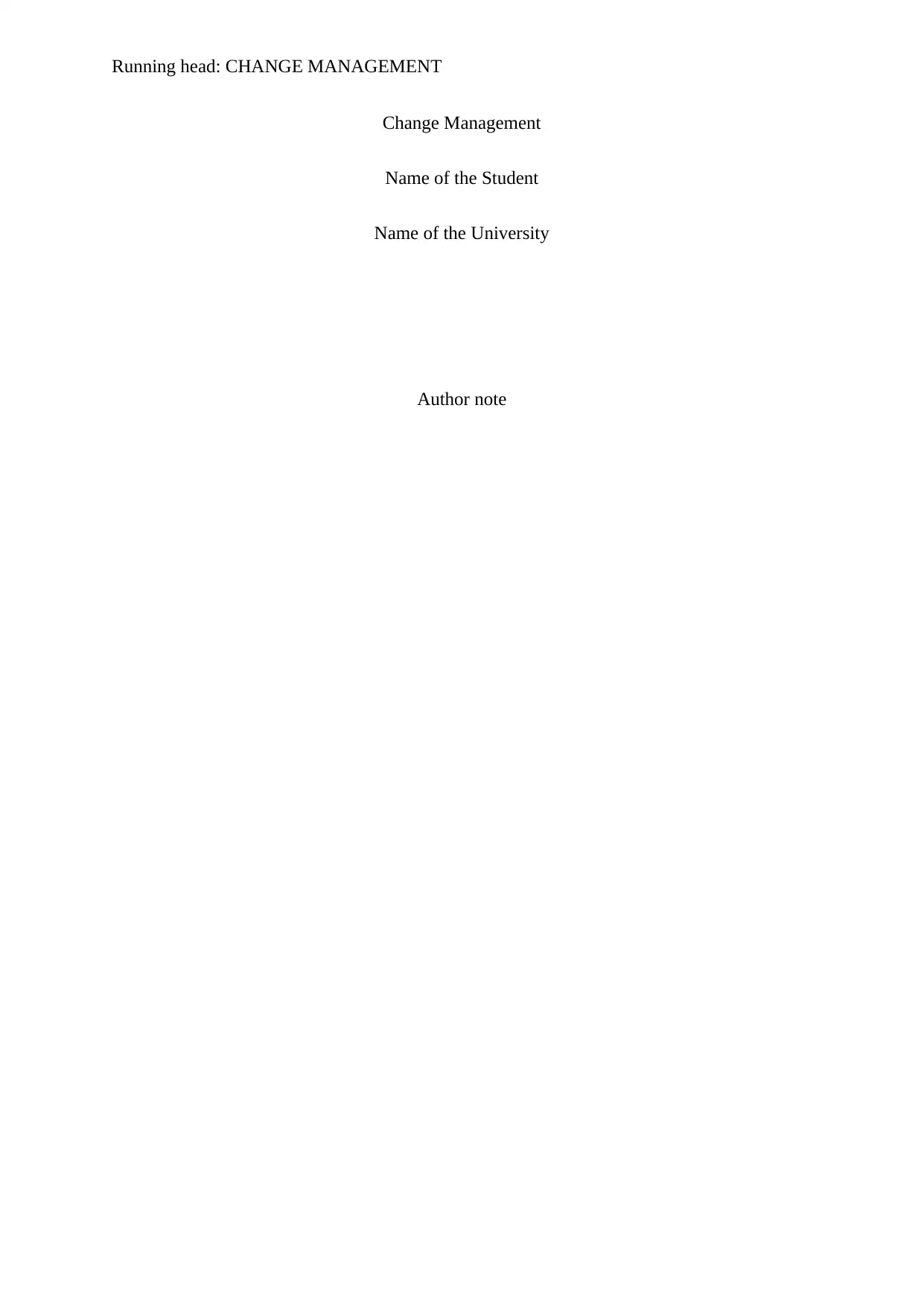
Running head: CHANGE MANAGEMENT
Change Management
Name of the Student
Name of the University
Author note
Change Management
Name of the Student
Name of the University
Author note
Paraphrase This Document
Need a fresh take? Get an instant paraphrase of this document with our AI Paraphraser
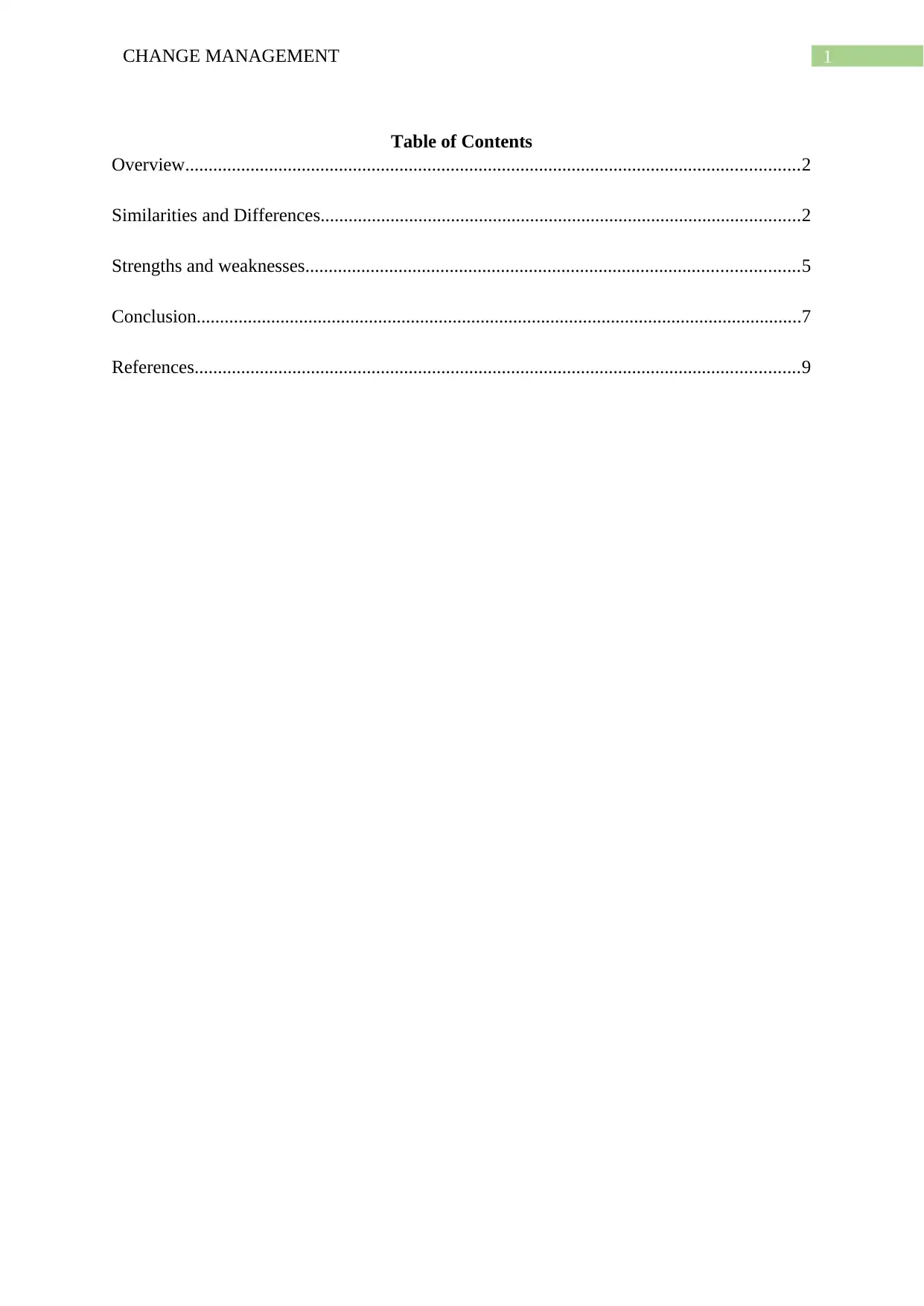
1CHANGE MANAGEMENT
Table of Contents
Overview....................................................................................................................................2
Similarities and Differences.......................................................................................................2
Strengths and weaknesses..........................................................................................................5
Conclusion..................................................................................................................................7
References..................................................................................................................................9
Table of Contents
Overview....................................................................................................................................2
Similarities and Differences.......................................................................................................2
Strengths and weaknesses..........................................................................................................5
Conclusion..................................................................................................................................7
References..................................................................................................................................9
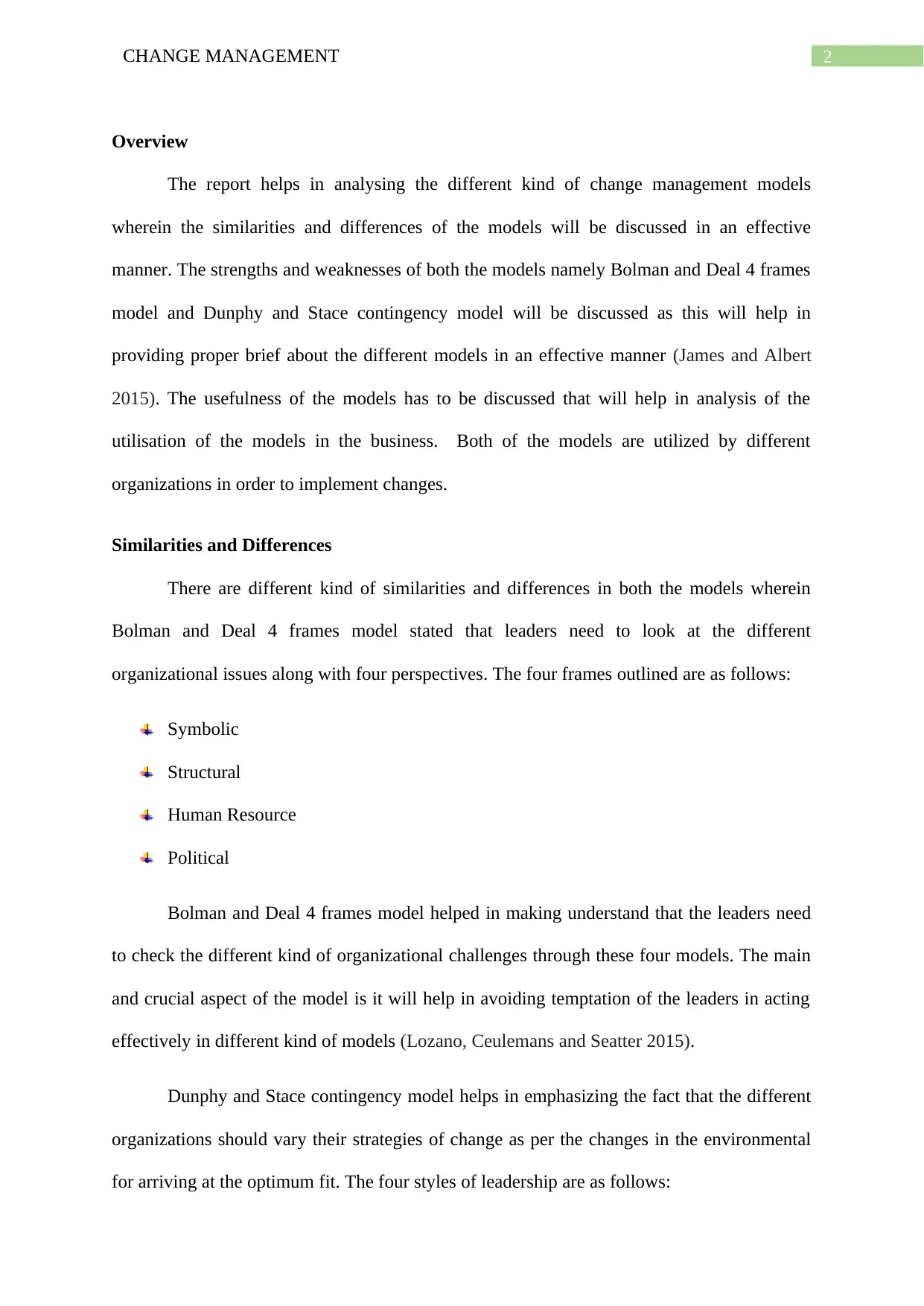
2CHANGE MANAGEMENT
Overview
The report helps in analysing the different kind of change management models
wherein the similarities and differences of the models will be discussed in an effective
manner. The strengths and weaknesses of both the models namely Bolman and Deal 4 frames
model and Dunphy and Stace contingency model will be discussed as this will help in
providing proper brief about the different models in an effective manner (James and Albert
2015). The usefulness of the models has to be discussed that will help in analysis of the
utilisation of the models in the business. Both of the models are utilized by different
organizations in order to implement changes.
Similarities and Differences
There are different kind of similarities and differences in both the models wherein
Bolman and Deal 4 frames model stated that leaders need to look at the different
organizational issues along with four perspectives. The four frames outlined are as follows:
Symbolic
Structural
Human Resource
Political
Bolman and Deal 4 frames model helped in making understand that the leaders need
to check the different kind of organizational challenges through these four models. The main
and crucial aspect of the model is it will help in avoiding temptation of the leaders in acting
effectively in different kind of models (Lozano, Ceulemans and Seatter 2015).
Dunphy and Stace contingency model helps in emphasizing the fact that the different
organizations should vary their strategies of change as per the changes in the environmental
for arriving at the optimum fit. The four styles of leadership are as follows:
Overview
The report helps in analysing the different kind of change management models
wherein the similarities and differences of the models will be discussed in an effective
manner. The strengths and weaknesses of both the models namely Bolman and Deal 4 frames
model and Dunphy and Stace contingency model will be discussed as this will help in
providing proper brief about the different models in an effective manner (James and Albert
2015). The usefulness of the models has to be discussed that will help in analysis of the
utilisation of the models in the business. Both of the models are utilized by different
organizations in order to implement changes.
Similarities and Differences
There are different kind of similarities and differences in both the models wherein
Bolman and Deal 4 frames model stated that leaders need to look at the different
organizational issues along with four perspectives. The four frames outlined are as follows:
Symbolic
Structural
Human Resource
Political
Bolman and Deal 4 frames model helped in making understand that the leaders need
to check the different kind of organizational challenges through these four models. The main
and crucial aspect of the model is it will help in avoiding temptation of the leaders in acting
effectively in different kind of models (Lozano, Ceulemans and Seatter 2015).
Dunphy and Stace contingency model helps in emphasizing the fact that the different
organizations should vary their strategies of change as per the changes in the environmental
for arriving at the optimum fit. The four styles of leadership are as follows:
⊘ This is a preview!⊘
Do you want full access?
Subscribe today to unlock all pages.

Trusted by 1+ million students worldwide
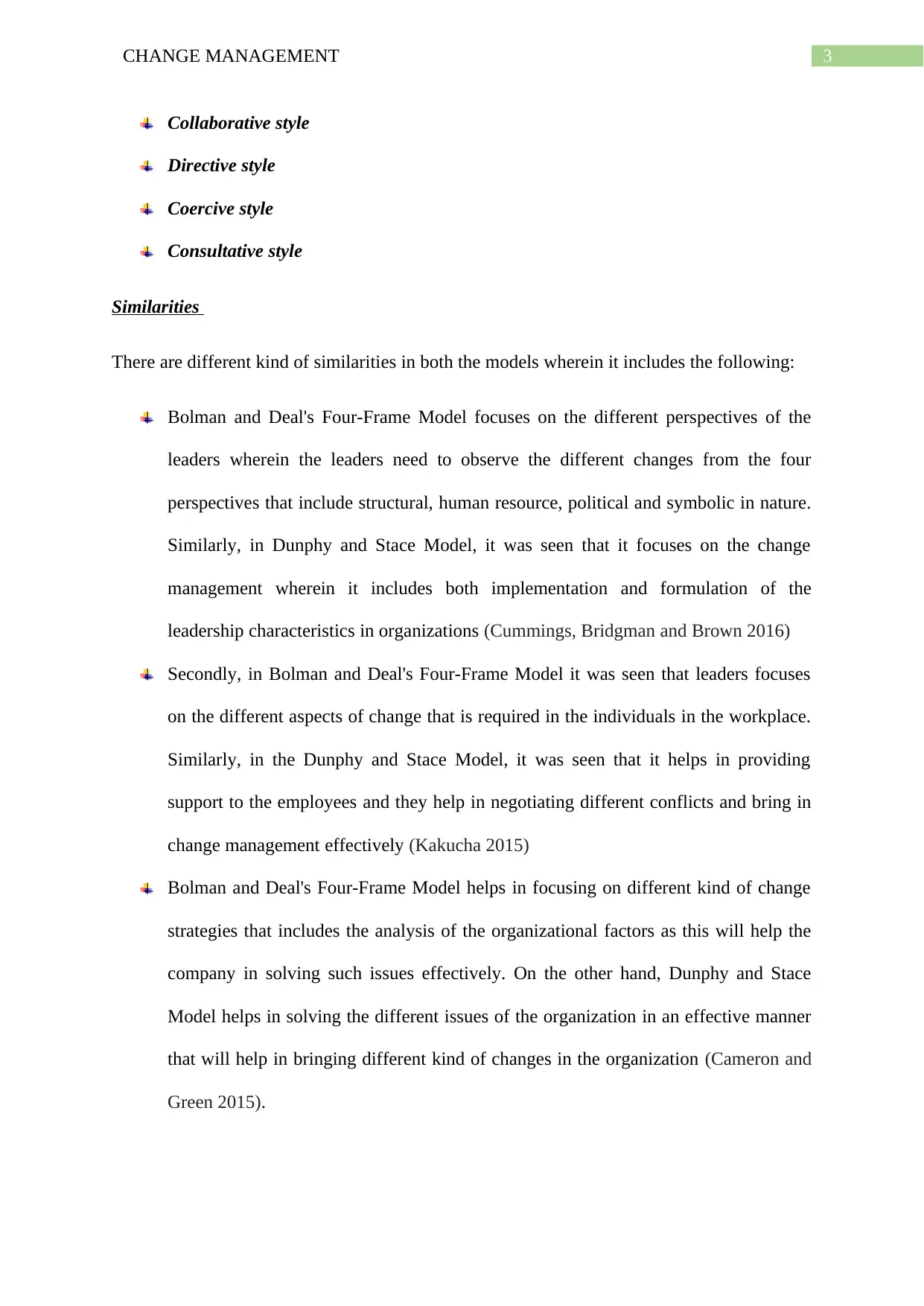
3CHANGE MANAGEMENT
Collaborative style
Directive style
Coercive style
Consultative style
Similarities
There are different kind of similarities in both the models wherein it includes the following:
Bolman and Deal's Four-Frame Model focuses on the different perspectives of the
leaders wherein the leaders need to observe the different changes from the four
perspectives that include structural, human resource, political and symbolic in nature.
Similarly, in Dunphy and Stace Model, it was seen that it focuses on the change
management wherein it includes both implementation and formulation of the
leadership characteristics in organizations (Cummings, Bridgman and Brown 2016)
Secondly, in Bolman and Deal's Four-Frame Model it was seen that leaders focuses
on the different aspects of change that is required in the individuals in the workplace.
Similarly, in the Dunphy and Stace Model, it was seen that it helps in providing
support to the employees and they help in negotiating different conflicts and bring in
change management effectively (Kakucha 2015)
Bolman and Deal's Four-Frame Model helps in focusing on different kind of change
strategies that includes the analysis of the organizational factors as this will help the
company in solving such issues effectively. On the other hand, Dunphy and Stace
Model helps in solving the different issues of the organization in an effective manner
that will help in bringing different kind of changes in the organization (Cameron and
Green 2015).
Collaborative style
Directive style
Coercive style
Consultative style
Similarities
There are different kind of similarities in both the models wherein it includes the following:
Bolman and Deal's Four-Frame Model focuses on the different perspectives of the
leaders wherein the leaders need to observe the different changes from the four
perspectives that include structural, human resource, political and symbolic in nature.
Similarly, in Dunphy and Stace Model, it was seen that it focuses on the change
management wherein it includes both implementation and formulation of the
leadership characteristics in organizations (Cummings, Bridgman and Brown 2016)
Secondly, in Bolman and Deal's Four-Frame Model it was seen that leaders focuses
on the different aspects of change that is required in the individuals in the workplace.
Similarly, in the Dunphy and Stace Model, it was seen that it helps in providing
support to the employees and they help in negotiating different conflicts and bring in
change management effectively (Kakucha 2015)
Bolman and Deal's Four-Frame Model helps in focusing on different kind of change
strategies that includes the analysis of the organizational factors as this will help the
company in solving such issues effectively. On the other hand, Dunphy and Stace
Model helps in solving the different issues of the organization in an effective manner
that will help in bringing different kind of changes in the organization (Cameron and
Green 2015).
Paraphrase This Document
Need a fresh take? Get an instant paraphrase of this document with our AI Paraphraser
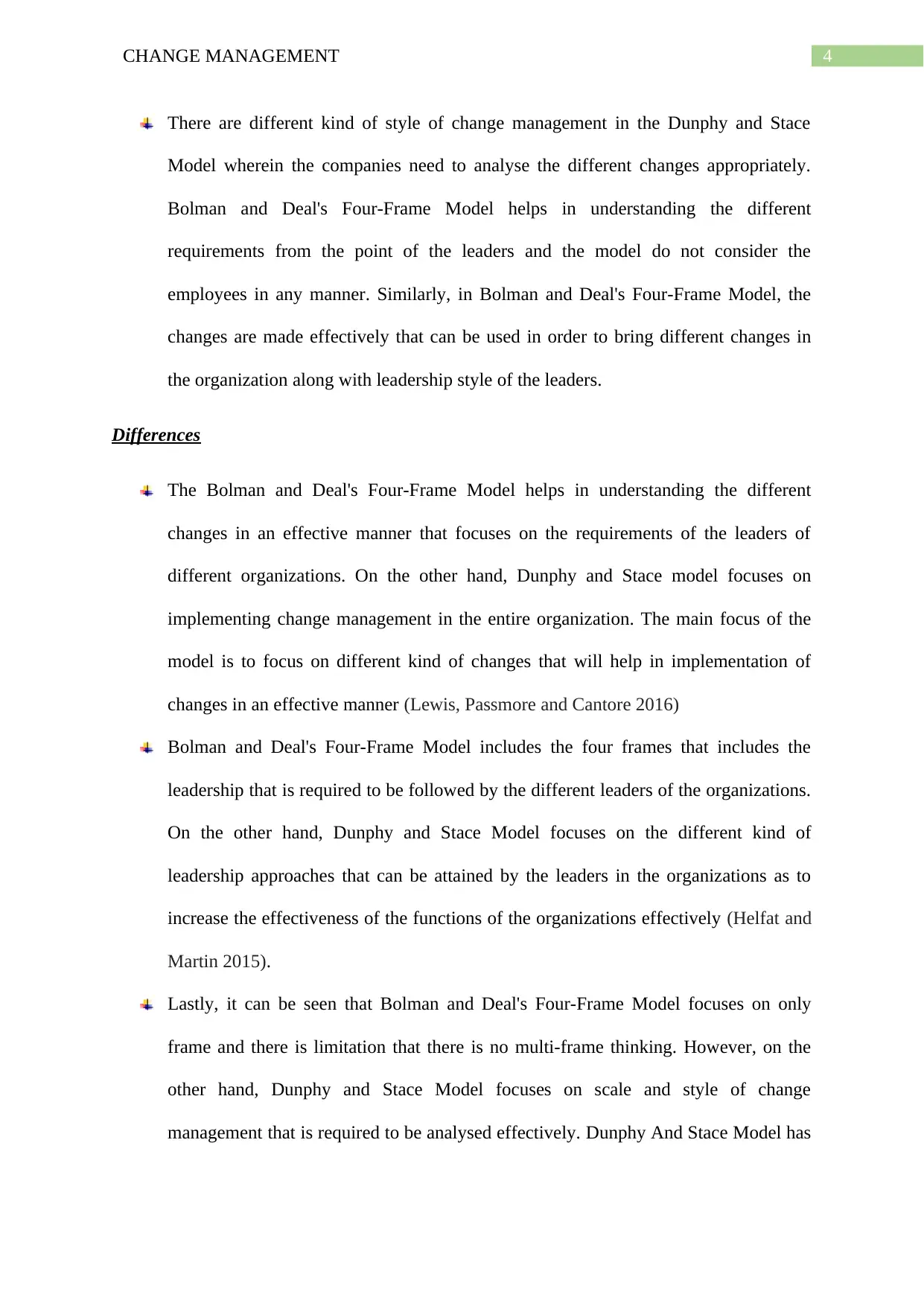
4CHANGE MANAGEMENT
There are different kind of style of change management in the Dunphy and Stace
Model wherein the companies need to analyse the different changes appropriately.
Bolman and Deal's Four-Frame Model helps in understanding the different
requirements from the point of the leaders and the model do not consider the
employees in any manner. Similarly, in Bolman and Deal's Four-Frame Model, the
changes are made effectively that can be used in order to bring different changes in
the organization along with leadership style of the leaders.
Differences
The Bolman and Deal's Four-Frame Model helps in understanding the different
changes in an effective manner that focuses on the requirements of the leaders of
different organizations. On the other hand, Dunphy and Stace model focuses on
implementing change management in the entire organization. The main focus of the
model is to focus on different kind of changes that will help in implementation of
changes in an effective manner (Lewis, Passmore and Cantore 2016)
Bolman and Deal's Four-Frame Model includes the four frames that includes the
leadership that is required to be followed by the different leaders of the organizations.
On the other hand, Dunphy and Stace Model focuses on the different kind of
leadership approaches that can be attained by the leaders in the organizations as to
increase the effectiveness of the functions of the organizations effectively (Helfat and
Martin 2015).
Lastly, it can be seen that Bolman and Deal's Four-Frame Model focuses on only
frame and there is limitation that there is no multi-frame thinking. However, on the
other hand, Dunphy and Stace Model focuses on scale and style of change
management that is required to be analysed effectively. Dunphy And Stace Model has
There are different kind of style of change management in the Dunphy and Stace
Model wherein the companies need to analyse the different changes appropriately.
Bolman and Deal's Four-Frame Model helps in understanding the different
requirements from the point of the leaders and the model do not consider the
employees in any manner. Similarly, in Bolman and Deal's Four-Frame Model, the
changes are made effectively that can be used in order to bring different changes in
the organization along with leadership style of the leaders.
Differences
The Bolman and Deal's Four-Frame Model helps in understanding the different
changes in an effective manner that focuses on the requirements of the leaders of
different organizations. On the other hand, Dunphy and Stace model focuses on
implementing change management in the entire organization. The main focus of the
model is to focus on different kind of changes that will help in implementation of
changes in an effective manner (Lewis, Passmore and Cantore 2016)
Bolman and Deal's Four-Frame Model includes the four frames that includes the
leadership that is required to be followed by the different leaders of the organizations.
On the other hand, Dunphy and Stace Model focuses on the different kind of
leadership approaches that can be attained by the leaders in the organizations as to
increase the effectiveness of the functions of the organizations effectively (Helfat and
Martin 2015).
Lastly, it can be seen that Bolman and Deal's Four-Frame Model focuses on only
frame and there is limitation that there is no multi-frame thinking. However, on the
other hand, Dunphy and Stace Model focuses on scale and style of change
management that is required to be analysed effectively. Dunphy And Stace Model has
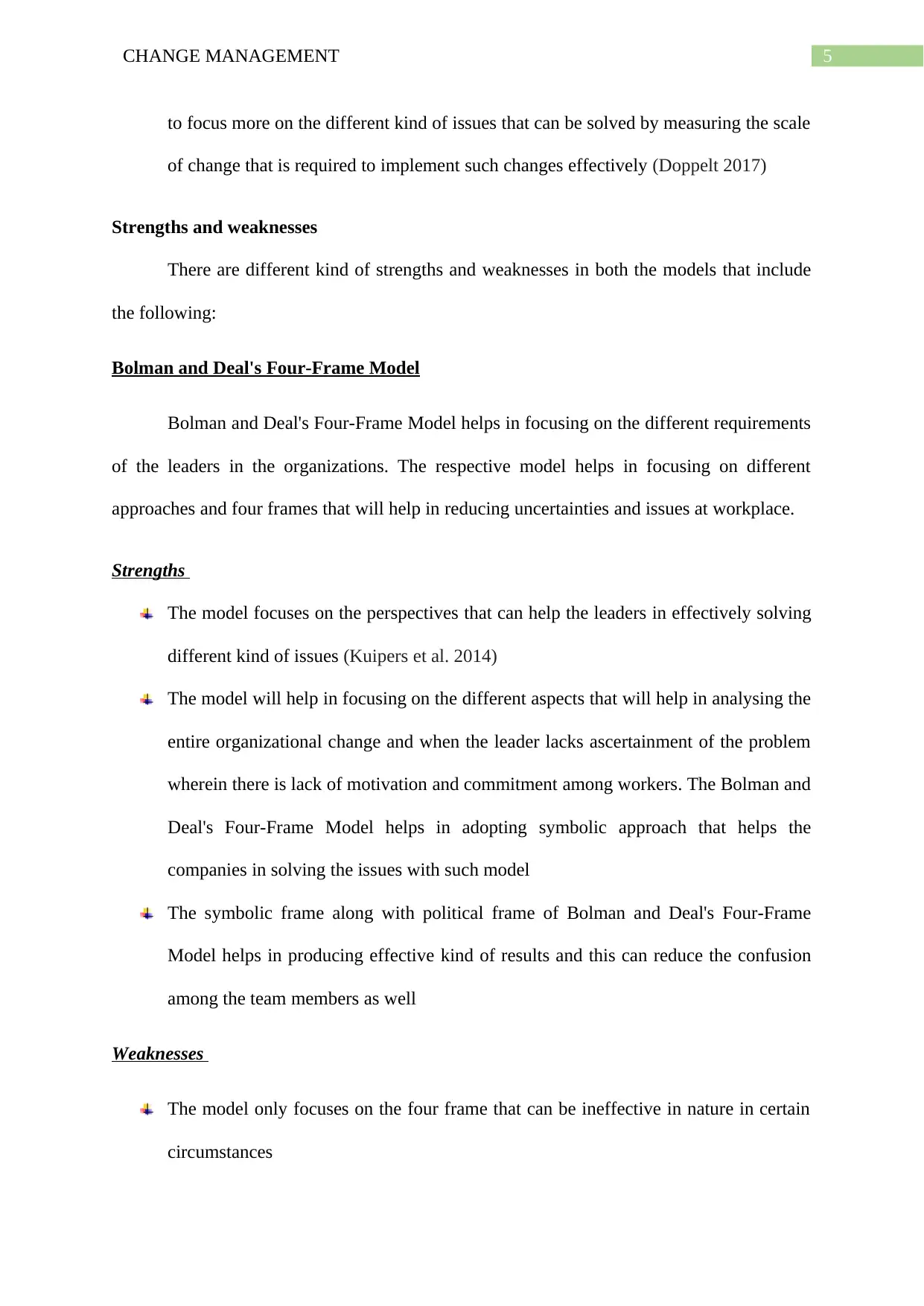
5CHANGE MANAGEMENT
to focus more on the different kind of issues that can be solved by measuring the scale
of change that is required to implement such changes effectively (Doppelt 2017)
Strengths and weaknesses
There are different kind of strengths and weaknesses in both the models that include
the following:
Bolman and Deal's Four-Frame Model
Bolman and Deal's Four-Frame Model helps in focusing on the different requirements
of the leaders in the organizations. The respective model helps in focusing on different
approaches and four frames that will help in reducing uncertainties and issues at workplace.
Strengths
The model focuses on the perspectives that can help the leaders in effectively solving
different kind of issues (Kuipers et al. 2014)
The model will help in focusing on the different aspects that will help in analysing the
entire organizational change and when the leader lacks ascertainment of the problem
wherein there is lack of motivation and commitment among workers. The Bolman and
Deal's Four-Frame Model helps in adopting symbolic approach that helps the
companies in solving the issues with such model
The symbolic frame along with political frame of Bolman and Deal's Four-Frame
Model helps in producing effective kind of results and this can reduce the confusion
among the team members as well
Weaknesses
The model only focuses on the four frame that can be ineffective in nature in certain
circumstances
to focus more on the different kind of issues that can be solved by measuring the scale
of change that is required to implement such changes effectively (Doppelt 2017)
Strengths and weaknesses
There are different kind of strengths and weaknesses in both the models that include
the following:
Bolman and Deal's Four-Frame Model
Bolman and Deal's Four-Frame Model helps in focusing on the different requirements
of the leaders in the organizations. The respective model helps in focusing on different
approaches and four frames that will help in reducing uncertainties and issues at workplace.
Strengths
The model focuses on the perspectives that can help the leaders in effectively solving
different kind of issues (Kuipers et al. 2014)
The model will help in focusing on the different aspects that will help in analysing the
entire organizational change and when the leader lacks ascertainment of the problem
wherein there is lack of motivation and commitment among workers. The Bolman and
Deal's Four-Frame Model helps in adopting symbolic approach that helps the
companies in solving the issues with such model
The symbolic frame along with political frame of Bolman and Deal's Four-Frame
Model helps in producing effective kind of results and this can reduce the confusion
among the team members as well
Weaknesses
The model only focuses on the four frame that can be ineffective in nature in certain
circumstances
⊘ This is a preview!⊘
Do you want full access?
Subscribe today to unlock all pages.

Trusted by 1+ million students worldwide
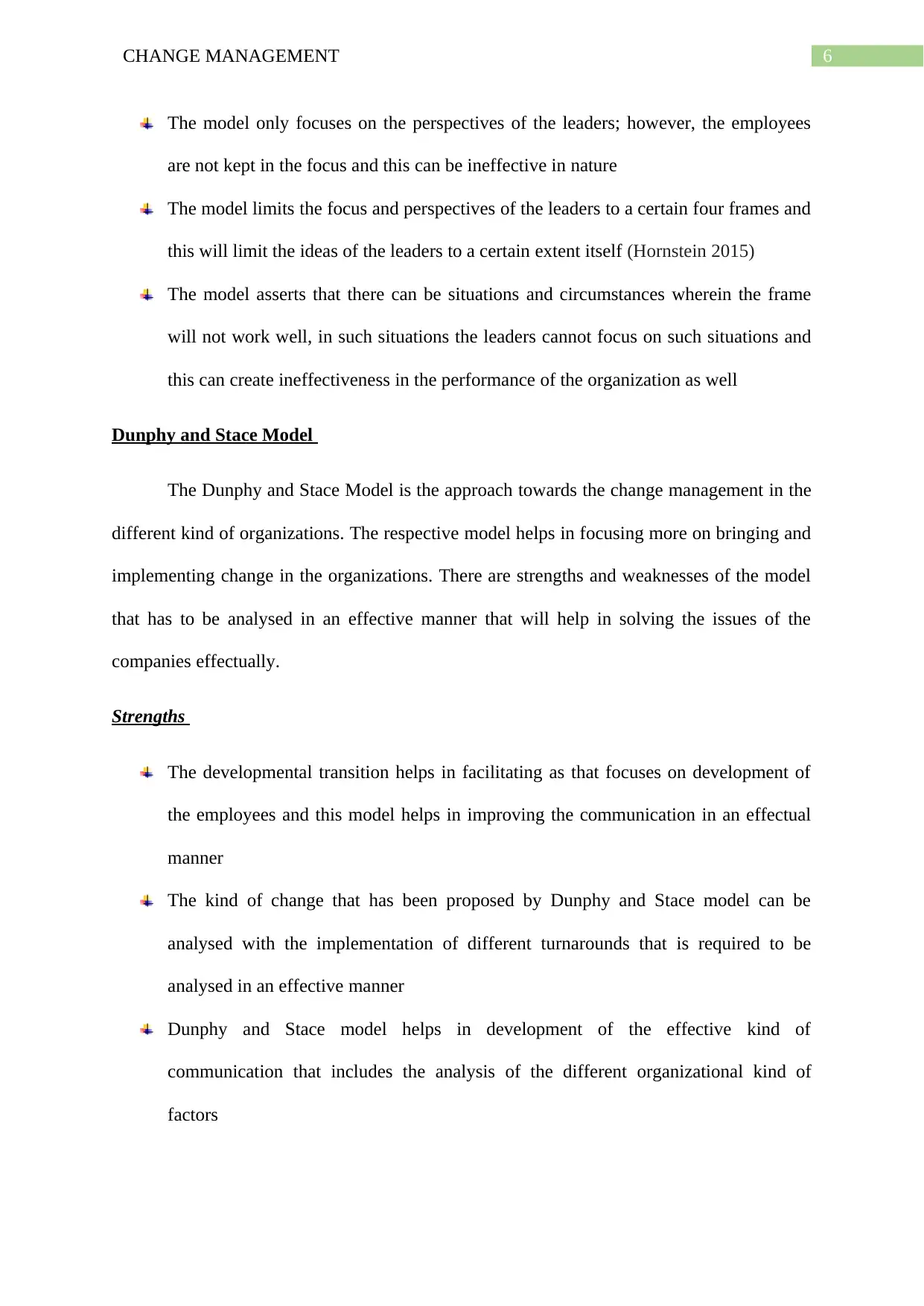
6CHANGE MANAGEMENT
The model only focuses on the perspectives of the leaders; however, the employees
are not kept in the focus and this can be ineffective in nature
The model limits the focus and perspectives of the leaders to a certain four frames and
this will limit the ideas of the leaders to a certain extent itself (Hornstein 2015)
The model asserts that there can be situations and circumstances wherein the frame
will not work well, in such situations the leaders cannot focus on such situations and
this can create ineffectiveness in the performance of the organization as well
Dunphy and Stace Model
The Dunphy and Stace Model is the approach towards the change management in the
different kind of organizations. The respective model helps in focusing more on bringing and
implementing change in the organizations. There are strengths and weaknesses of the model
that has to be analysed in an effective manner that will help in solving the issues of the
companies effectually.
Strengths
The developmental transition helps in facilitating as that focuses on development of
the employees and this model helps in improving the communication in an effectual
manner
The kind of change that has been proposed by Dunphy and Stace model can be
analysed with the implementation of different turnarounds that is required to be
analysed in an effective manner
Dunphy and Stace model helps in development of the effective kind of
communication that includes the analysis of the different organizational kind of
factors
The model only focuses on the perspectives of the leaders; however, the employees
are not kept in the focus and this can be ineffective in nature
The model limits the focus and perspectives of the leaders to a certain four frames and
this will limit the ideas of the leaders to a certain extent itself (Hornstein 2015)
The model asserts that there can be situations and circumstances wherein the frame
will not work well, in such situations the leaders cannot focus on such situations and
this can create ineffectiveness in the performance of the organization as well
Dunphy and Stace Model
The Dunphy and Stace Model is the approach towards the change management in the
different kind of organizations. The respective model helps in focusing more on bringing and
implementing change in the organizations. There are strengths and weaknesses of the model
that has to be analysed in an effective manner that will help in solving the issues of the
companies effectually.
Strengths
The developmental transition helps in facilitating as that focuses on development of
the employees and this model helps in improving the communication in an effectual
manner
The kind of change that has been proposed by Dunphy and Stace model can be
analysed with the implementation of different turnarounds that is required to be
analysed in an effective manner
Dunphy and Stace model helps in development of the effective kind of
communication that includes the analysis of the different organizational kind of
factors
Paraphrase This Document
Need a fresh take? Get an instant paraphrase of this document with our AI Paraphraser
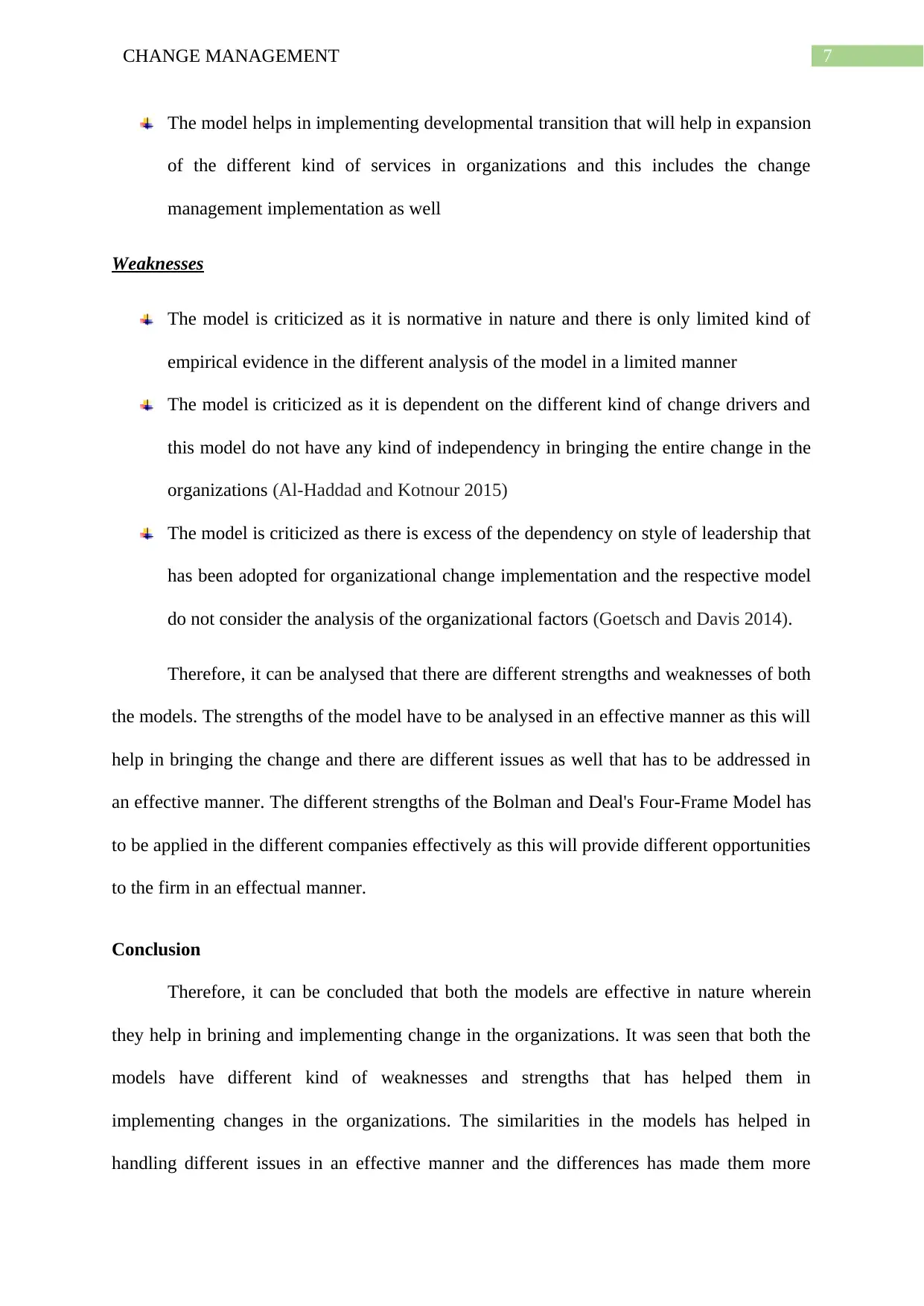
7CHANGE MANAGEMENT
The model helps in implementing developmental transition that will help in expansion
of the different kind of services in organizations and this includes the change
management implementation as well
Weaknesses
The model is criticized as it is normative in nature and there is only limited kind of
empirical evidence in the different analysis of the model in a limited manner
The model is criticized as it is dependent on the different kind of change drivers and
this model do not have any kind of independency in bringing the entire change in the
organizations (Al-Haddad and Kotnour 2015)
The model is criticized as there is excess of the dependency on style of leadership that
has been adopted for organizational change implementation and the respective model
do not consider the analysis of the organizational factors (Goetsch and Davis 2014).
Therefore, it can be analysed that there are different strengths and weaknesses of both
the models. The strengths of the model have to be analysed in an effective manner as this will
help in bringing the change and there are different issues as well that has to be addressed in
an effective manner. The different strengths of the Bolman and Deal's Four-Frame Model has
to be applied in the different companies effectively as this will provide different opportunities
to the firm in an effectual manner.
Conclusion
Therefore, it can be concluded that both the models are effective in nature wherein
they help in brining and implementing change in the organizations. It was seen that both the
models have different kind of weaknesses and strengths that has helped them in
implementing changes in the organizations. The similarities in the models has helped in
handling different issues in an effective manner and the differences has made them more
The model helps in implementing developmental transition that will help in expansion
of the different kind of services in organizations and this includes the change
management implementation as well
Weaknesses
The model is criticized as it is normative in nature and there is only limited kind of
empirical evidence in the different analysis of the model in a limited manner
The model is criticized as it is dependent on the different kind of change drivers and
this model do not have any kind of independency in bringing the entire change in the
organizations (Al-Haddad and Kotnour 2015)
The model is criticized as there is excess of the dependency on style of leadership that
has been adopted for organizational change implementation and the respective model
do not consider the analysis of the organizational factors (Goetsch and Davis 2014).
Therefore, it can be analysed that there are different strengths and weaknesses of both
the models. The strengths of the model have to be analysed in an effective manner as this will
help in bringing the change and there are different issues as well that has to be addressed in
an effective manner. The different strengths of the Bolman and Deal's Four-Frame Model has
to be applied in the different companies effectively as this will provide different opportunities
to the firm in an effectual manner.
Conclusion
Therefore, it can be concluded that both the models are effective in nature wherein
they help in brining and implementing change in the organizations. It was seen that both the
models have different kind of weaknesses and strengths that has helped them in
implementing changes in the organizations. The similarities in the models has helped in
handling different issues in an effective manner and the differences has made them more
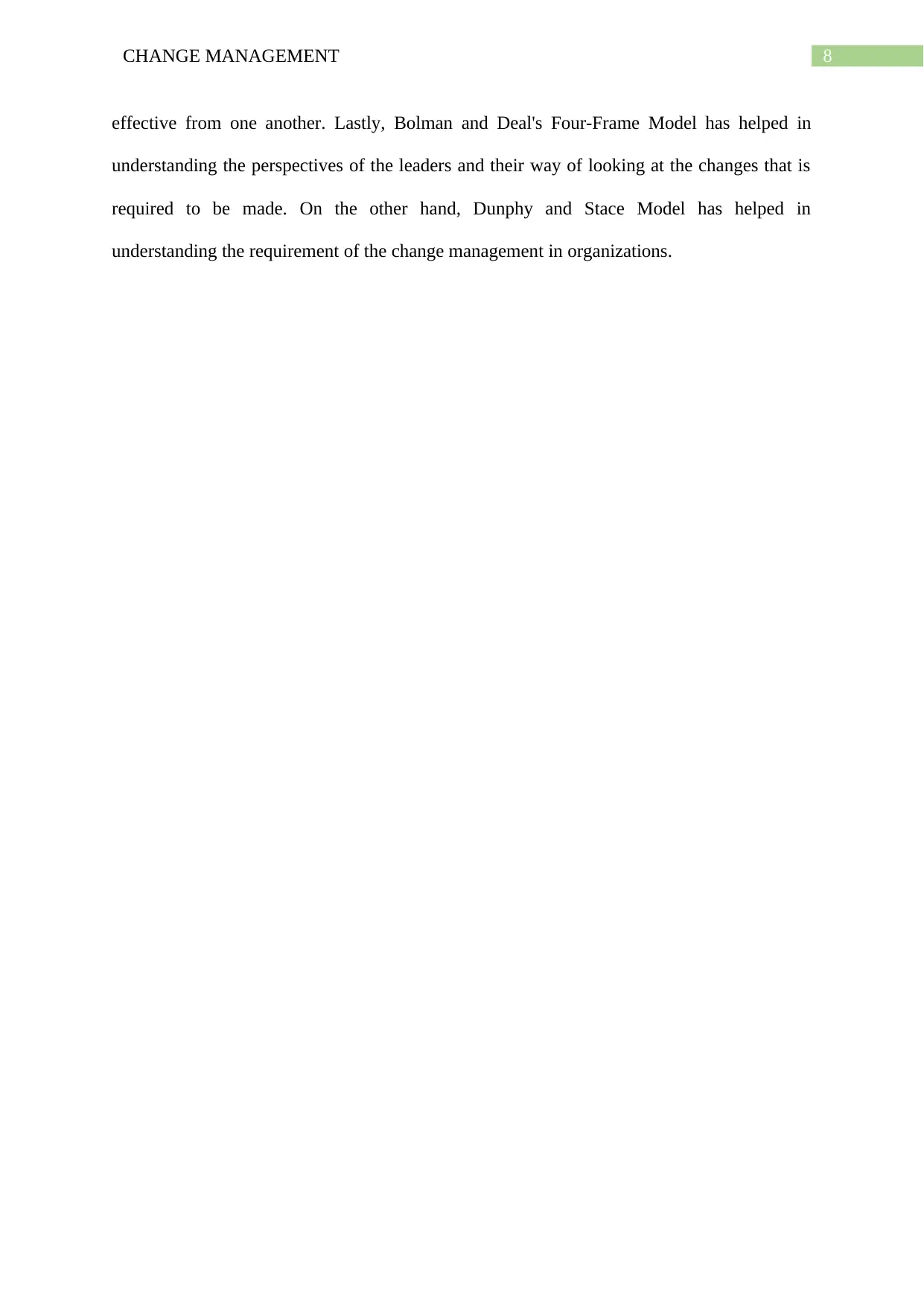
8CHANGE MANAGEMENT
effective from one another. Lastly, Bolman and Deal's Four-Frame Model has helped in
understanding the perspectives of the leaders and their way of looking at the changes that is
required to be made. On the other hand, Dunphy and Stace Model has helped in
understanding the requirement of the change management in organizations.
effective from one another. Lastly, Bolman and Deal's Four-Frame Model has helped in
understanding the perspectives of the leaders and their way of looking at the changes that is
required to be made. On the other hand, Dunphy and Stace Model has helped in
understanding the requirement of the change management in organizations.
⊘ This is a preview!⊘
Do you want full access?
Subscribe today to unlock all pages.

Trusted by 1+ million students worldwide
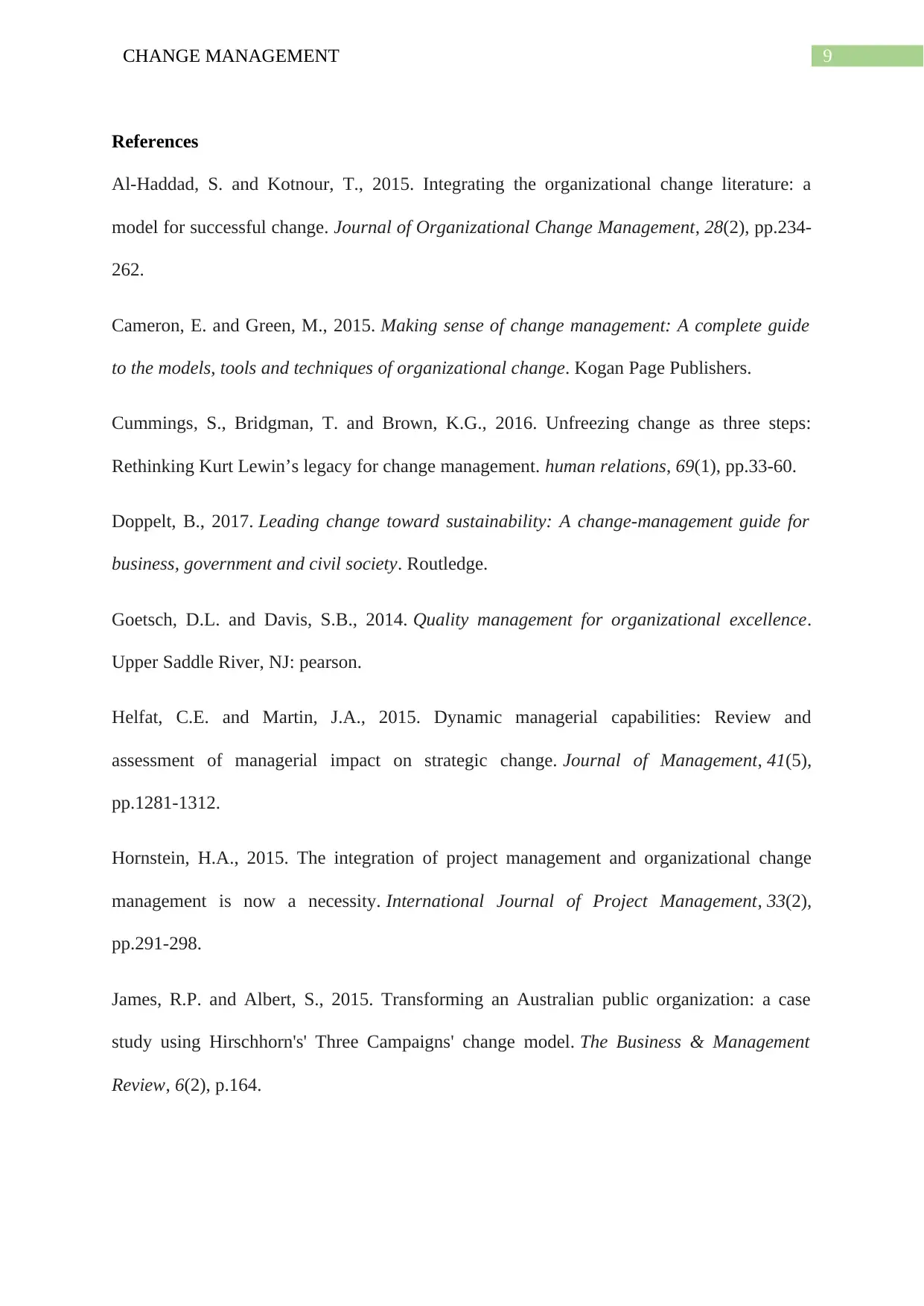
9CHANGE MANAGEMENT
References
Al-Haddad, S. and Kotnour, T., 2015. Integrating the organizational change literature: a
model for successful change. Journal of Organizational Change Management, 28(2), pp.234-
262.
Cameron, E. and Green, M., 2015. Making sense of change management: A complete guide
to the models, tools and techniques of organizational change. Kogan Page Publishers.
Cummings, S., Bridgman, T. and Brown, K.G., 2016. Unfreezing change as three steps:
Rethinking Kurt Lewin’s legacy for change management. human relations, 69(1), pp.33-60.
Doppelt, B., 2017. Leading change toward sustainability: A change-management guide for
business, government and civil society. Routledge.
Goetsch, D.L. and Davis, S.B., 2014. Quality management for organizational excellence.
Upper Saddle River, NJ: pearson.
Helfat, C.E. and Martin, J.A., 2015. Dynamic managerial capabilities: Review and
assessment of managerial impact on strategic change. Journal of Management, 41(5),
pp.1281-1312.
Hornstein, H.A., 2015. The integration of project management and organizational change
management is now a necessity. International Journal of Project Management, 33(2),
pp.291-298.
James, R.P. and Albert, S., 2015. Transforming an Australian public organization: a case
study using Hirschhorn's' Three Campaigns' change model. The Business & Management
Review, 6(2), p.164.
References
Al-Haddad, S. and Kotnour, T., 2015. Integrating the organizational change literature: a
model for successful change. Journal of Organizational Change Management, 28(2), pp.234-
262.
Cameron, E. and Green, M., 2015. Making sense of change management: A complete guide
to the models, tools and techniques of organizational change. Kogan Page Publishers.
Cummings, S., Bridgman, T. and Brown, K.G., 2016. Unfreezing change as three steps:
Rethinking Kurt Lewin’s legacy for change management. human relations, 69(1), pp.33-60.
Doppelt, B., 2017. Leading change toward sustainability: A change-management guide for
business, government and civil society. Routledge.
Goetsch, D.L. and Davis, S.B., 2014. Quality management for organizational excellence.
Upper Saddle River, NJ: pearson.
Helfat, C.E. and Martin, J.A., 2015. Dynamic managerial capabilities: Review and
assessment of managerial impact on strategic change. Journal of Management, 41(5),
pp.1281-1312.
Hornstein, H.A., 2015. The integration of project management and organizational change
management is now a necessity. International Journal of Project Management, 33(2),
pp.291-298.
James, R.P. and Albert, S., 2015. Transforming an Australian public organization: a case
study using Hirschhorn's' Three Campaigns' change model. The Business & Management
Review, 6(2), p.164.
Paraphrase This Document
Need a fresh take? Get an instant paraphrase of this document with our AI Paraphraser
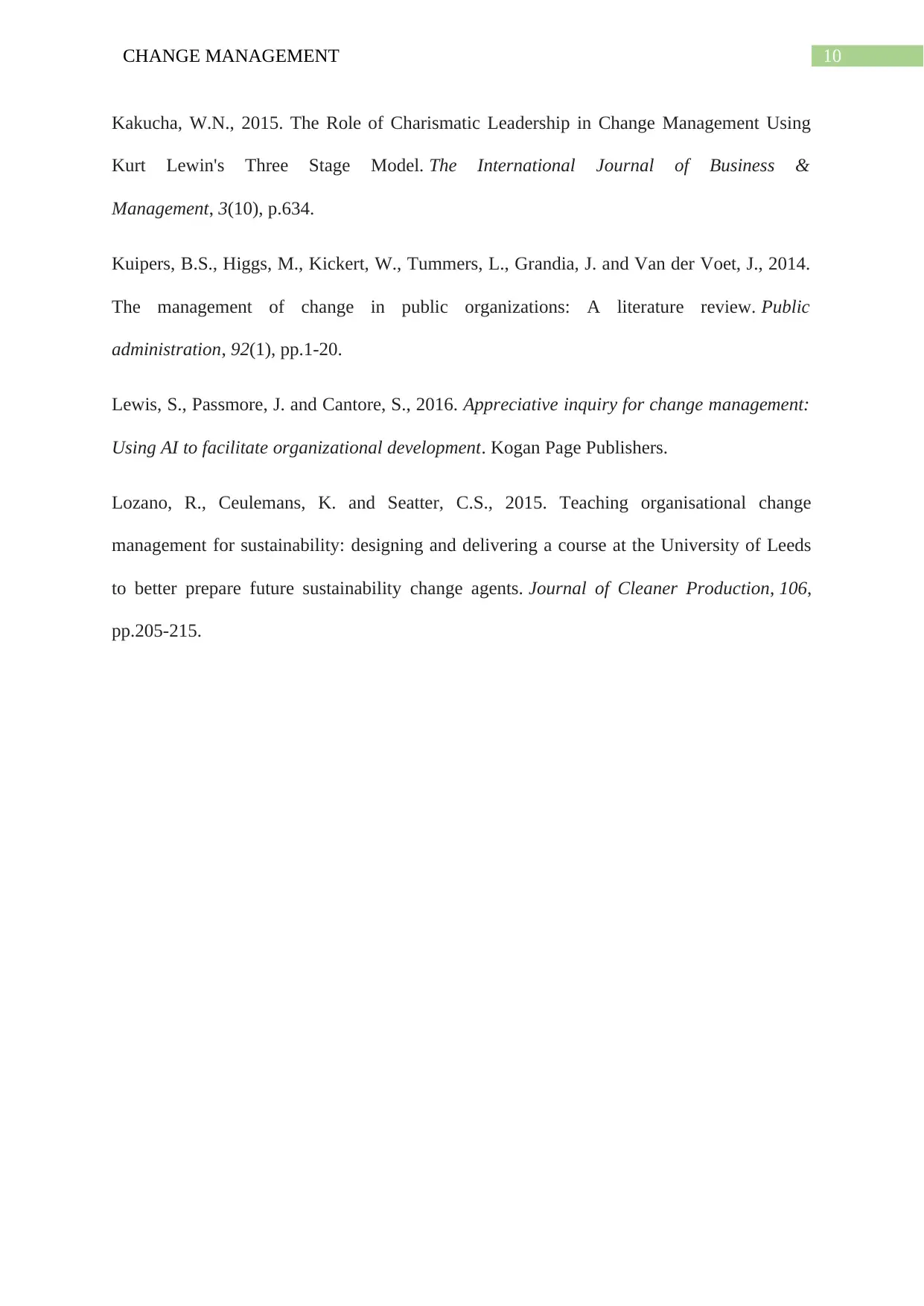
10CHANGE MANAGEMENT
Kakucha, W.N., 2015. The Role of Charismatic Leadership in Change Management Using
Kurt Lewin's Three Stage Model. The International Journal of Business &
Management, 3(10), p.634.
Kuipers, B.S., Higgs, M., Kickert, W., Tummers, L., Grandia, J. and Van der Voet, J., 2014.
The management of change in public organizations: A literature review. Public
administration, 92(1), pp.1-20.
Lewis, S., Passmore, J. and Cantore, S., 2016. Appreciative inquiry for change management:
Using AI to facilitate organizational development. Kogan Page Publishers.
Lozano, R., Ceulemans, K. and Seatter, C.S., 2015. Teaching organisational change
management for sustainability: designing and delivering a course at the University of Leeds
to better prepare future sustainability change agents. Journal of Cleaner Production, 106,
pp.205-215.
Kakucha, W.N., 2015. The Role of Charismatic Leadership in Change Management Using
Kurt Lewin's Three Stage Model. The International Journal of Business &
Management, 3(10), p.634.
Kuipers, B.S., Higgs, M., Kickert, W., Tummers, L., Grandia, J. and Van der Voet, J., 2014.
The management of change in public organizations: A literature review. Public
administration, 92(1), pp.1-20.
Lewis, S., Passmore, J. and Cantore, S., 2016. Appreciative inquiry for change management:
Using AI to facilitate organizational development. Kogan Page Publishers.
Lozano, R., Ceulemans, K. and Seatter, C.S., 2015. Teaching organisational change
management for sustainability: designing and delivering a course at the University of Leeds
to better prepare future sustainability change agents. Journal of Cleaner Production, 106,
pp.205-215.
1 out of 11
Related Documents
Your All-in-One AI-Powered Toolkit for Academic Success.
+13062052269
info@desklib.com
Available 24*7 on WhatsApp / Email
![[object Object]](/_next/static/media/star-bottom.7253800d.svg)
Unlock your academic potential
Copyright © 2020–2025 A2Z Services. All Rights Reserved. Developed and managed by ZUCOL.





